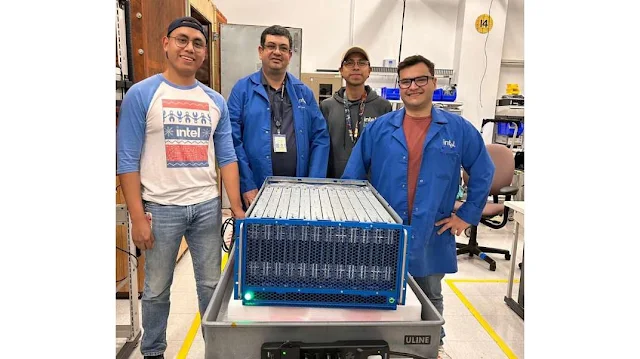
Neuromorphic systems are designed to imitate the electrical properties of real neurons, found in human brain, more closely, which could speed up computation and use less energy.
Intel's Hala Point is an advanced neuromorphic system designed to emulate the intricate workings of the human brain. It contains an impressive 1.15 billion neurons. To put this into perspective, that's more neurons than there are stars in our Milky Way galaxy!
 |
| Hala Point, contains 1.15 billion neurons for more sustainable Al. (Credit: Intel Corporation) |
 |
At the heart of Hala Point lies Intel’s Loihi 2 processor, a marvel of engineering. This processor is specifically designed for brain-inspired computing and enables efficient and scalable AI. It combines deep learning efficiency with novel brain-inspired learning and optimization capabilities.
Hala Point demonstrates state-of-the-art computational efficiencies on mainstream AI workloads. It can support up to 20 quadrillion operations per second (20 petaops) with an efficiency exceeding 15 trillion 8-bit operations per second per watts (TOPS/W) when executing conventional deep neural networks. These levels rival and even exceed architectures built on graphics processing units (GPUs) and central processing units (CPUs).
Hala Point demonstrates state-of-the-art computational efficiencies on mainstream AI workloads. It can support up to 20 quadrillion operations per second (20 petaops) with an efficiency exceeding 15 trillion 8-bit operations per second per watts (TOPS/W) when executing conventional deep neural networks. These levels rival and even exceed architectures built on graphics processing units (GPUs) and central processing units (CPUs).
Applications:
Hala Point's unique capabilities open up exciting possibilities for real-time continuous learning in various AI applications. These include:- Scientific and Engineering Problem-Solving: Researchers can leverage Hala Point for solving complex scientific and engineering challenges.
- Logistics and Smart City Infrastructure Management: The system can enhance logistics and optimize smart city operations.
- Large Language Models (LLMs): Hala Point could contribute to the development of more powerful language models.
- AI Agents: It has the potential to improve AI agents' adaptability and efficiency.
This achievement by Intel underscores the importance of brain-inspired computing and its potential impact on the future of AI. With Hala Point, we're moving closer to unlocking new frontiers in artificial intelligence.
"The computing cost of today’s AI models is rising at unsustainable rates. The industry needs fundamentally new approaches capable of scaling. For that reason, we developed Hala Point, which combines deep learning efficiency with novel brain-inspired learning and optimization capabilities. We hope that research with Hala Point will advance the efficiency and adaptability of large-scale AI technology," Mike Davies, director of the Neuromorphic Computing Lab at Intel Labs.
Conventional Al systems, including those based on deep learning, rely on silicon-based computer architectures (such as CPUs and GPUs). These architectures were originally designed for general-purpose computing and do not directly mimic the brain's structure.
Neuromorphic computing, on the other hand, emulates the human brain's mechanisms within its architecture. It takes inspiration from the brain's neural networks, neurons, and synapses. The goal is to create hardware that operates more like the brain, enabling efficient and brain-inspired computation








 IndianWeb2.com is an independent digital media platform for business, entrepreneurship, science, technology, startups, gadgets and climate change news & reviews.
IndianWeb2.com is an independent digital media platform for business, entrepreneurship, science, technology, startups, gadgets and climate change news & reviews.
No comments
Post a Comment